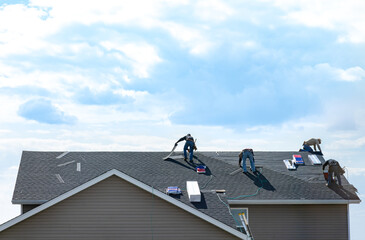Residential roofs are designed with aesthetics in mind. However, they also take into consideration functionality and building codes. Roofing materials for residential homes include wood, asphalt shingles, slate, and metal. For residential roofing expertise, contact Roofing Columbus GA.
 Some of these are more expensive than others. Cedar shakes, for example, offer a traditional look, while metal offers superior durability.
Some of these are more expensive than others. Cedar shakes, for example, offer a traditional look, while metal offers superior durability.
Asphalt shingles are one of the most common roofing materials for homes durability and energy efficiency. In addition, asphalt shingles are also affordable and easy to install. They come in various colors and blend seamlessly with various aesthetics. Asphalt shingles are a great choice for any home because they can handle extreme weather conditions and still look beautiful.
Three main types of asphalt shingles are on the market today – strip, dimensional, and luxury. Strip shingles are usually made of organic or fiberglass materials, covered with adhesive asphalt and mineral granules. Those with an organic base mat have fillers, such as wood fibers or cellulose, which help it to resist fire and improve durability. Those with a fiberglass base have a reinforcing mat that is bonded to a layer of asphalt with urea-formaldehyde resin, then coated with a solid coating of adhesive asphalt and topped with mineral granules.
The most popular type of residential shingle, dimensional or architectural shingles are made with multiple layers to give your roof a richer and more varied appearance. They also tend to be heavier than strip shingles, which means they have better protection against wind and hail damage. They are often called designer shingles or premium shingles because they offer a more luxurious aesthetic while adding value to your home.
Luxury shingles, also known as laminate or dimensional shingles, are thicker and have more layers than standard asphalt shingles. They are designed to replicate the aesthetics of high-end wood shake or natural slate shingles while providing added strength and durability. They are typically more expensive than other types of shingles, but they do provide a number of advantages that make them well worth the investment.
All of these different types of shingles are suitable for most homes, but each has its own strengths and weaknesses. When choosing a roof shingle, be sure to consider your budget and the amount of maintenance you are willing to do. Then, find a quality manufacturer that offers a warranty on their products and has an excellent reputation. With proper installation and good attic ventilation, an asphalt shingle roof can last for decades.
Wood
There are many different types of residential roofing materials available, each with its own advantages and drawbacks. Asphalt shingles are the most popular choice, but other options include metal, tile, and wood shakes. Each type of roofing material has its own unique characteristics, but all are designed to provide proper ventilation and insulation for your home. This helps to reduce heat drive into conditioned living spaces and prevents condensation that can damage interior paint and wallpaper.
Choosing the right roof system for your home will depend on your budget and the style of your house. You will want to consider the climate in your area and whether you are prone to extreme weather events like hail or high winds. It is also important to take into account the cost of maintenance and replacement.
Wood shingles are an organic natural material that is both eco-friendly and durable. They can last up to 30 years depending on the thickness, edge grain, and cut type. Wood shingles are relatively lightweight compared to other roofing materials, making them easy to transport and install on the roof. They can be carved into custom shapes and designs to enhance the appearance of your home.
Cedar is a popular type of wood shingle because it provides better insulation than other types of roofing. This means you can save money on your energy bills all year round. Cedar is also more resistant to moisture and can withstand higher temperatures than other types of roofing.
There are several types of wood shingles including flat, edge grain, and slash grain. Edge grain is the highest quality because it is cut perpendicular to the tree’s rings. This results in a stronger shingle that is less likely to distort over time. Flat and slash grain shingles are cheaper, but they are not as durable.
While wood shingles have been in use for centuries, they are not recommended for homes located in wildfire-prone areas. They are also prone to insect infestations, so you will need to stock up on wasp spray when installing this type of roofing. However, the rustic look of a wooden roof can add a charming element to your home.
Rolled Roofing
Rolled roofing is another roof covering option that is popular in residential areas. This type of roofing is typically made from mineral-surfaced material that comes in large rolls and can be installed easily on a flat roof. This material is inexpensive and may not require professional installation, which can help keep overall project costs down. Rolled roofing is suitable for a variety of structures, including sheds, lean-tos, garages and workshops. It also works well for re-roofing existing homes or buildings.
Roll roofing can be applied over an existing roof, as long as the existing roof is free from debris, gravel and other materials that could puncture or damage the material. It can also be used for re-roofing small structures, such as sheds and gazebos. This roofing is also commonly used for different types of building renovations, such as remodeling a barn or adding an addition to a house.
It is important to consider all of the pros and cons of rolled roofing before making a final decision. For example, rolled roofing can be susceptible to wind and rain damage due to its thinner composition and installation method. It is also not designed for steep-sloped roofs and may not provide adequate water drainage in these conditions. Furthermore, this type of roof does not offer much insulation properties, so additional energy efficiency measures may be needed.
One of the most common types of rolled roofing is known as modified bitumen (MBR) roofing. This type of roofing is available in several different options, including torch down, self-adhering and adhesive methods. It can last for up to 20 years, depending on the climate.
MBR roofing is a good alternative to shingle roofing because it provides an effective waterproof barrier that can withstand most weather conditions. Its durability and longevity make it a great choice for a commercial or industrial roof, as well as for residential use.
A good way to ensure a long lifespan for your rolled roofing is to practice proper maintenance. This includes regular cleaning to prevent the buildup of dirt and debris. You should also regularly trim overhanging branches and remove snow accumulation to minimize stress on the roof surface.
Concrete Tiles
A concrete tile roof adds old-world charm to a home while minimizing external noise and contributing towards a safe and healthy environment. They are non-toxic, wind and fire-resistant, and the tiles themselves are made of earth minerals that can be pulverized and recycled. Additionally, because they reflect sunlight, homeowners in warm-sunny climates report lower energy costs to cool their homes. Conversely, in colder climates, they help insulate the house from freezing temperatures and lessen heating costs.
Unlike asphalt shingles, which are manufactured from petroleum products and are prone to a variety of issues including fire, mold and chemicals, concrete roofing tiles are made from recycled materials such as glass, rock salt and cement. They are also non-combustible and fire-resistant. Concrete tile roofs can last 50 years or more and are easy to maintain with a few precautions.
For example, you should remove tree branches and leaves that can cause the tiles to become tangled or broken. You should also regularly clean the roof with a power washer to remove dirt and debris that can build up on the surface. Finally, because of their density, a tile roof should be inspected for any cracks or displaced pieces.
Concrete roof tiles are available in a wide range of colors and styles to match any home décor, from medieval to contemporary European. They can also be designed to resemble traditional shingle, wood shake or slate roofing.
Cement tiles are manufactured by hydraulically pressing sand, pigment, cement, and other additives over a dry concrete base. They are a durable and weather-resistant roofing option that can be resurfaced to provide long-lasting protection. They can withstand high winds and carry a Class A fire rating.
While the upfront cost for a tile roof is more than that of an asphalt shingle roof, it provides a higher ROI over time because they are extremely durable and require low maintenance. Additionally, they reduce energy costs while adding value to a property. If you’re interested in a new tile roof for your home, contact Sol Vista today to request a free estimate!


 Residential roof maintenance is a vital part of maintaining the integrity of your home. Aside from normal wear and tear, roofs are susceptible to damage caused by weather, pests, rodents, debris, and age. Regular maintenance and inspection can prevent these problems and shorten your roof’s life. Having professional
Residential roof maintenance is a vital part of maintaining the integrity of your home. Aside from normal wear and tear, roofs are susceptible to damage caused by weather, pests, rodents, debris, and age. Regular maintenance and inspection can prevent these problems and shorten your roof’s life. Having professional 
 If you’re shopping for a moving company, look for one that lists their credentials on its website or is willing to provide them upon request. Ask what their job title is, and get that name and contact information in writing. Also, find out who will oversee your project from start to finish. It’s not enough to hire a friendly salesperson who will take your details and write up a contract; you need a project manager who will be on site, overseeing the work.
If you’re shopping for a moving company, look for one that lists their credentials on its website or is willing to provide them upon request. Ask what their job title is, and get that name and contact information in writing. Also, find out who will oversee your project from start to finish. It’s not enough to hire a friendly salesperson who will take your details and write up a contract; you need a project manager who will be on site, overseeing the work.